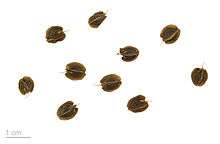Rheum palmatum
| Chinese rhubarb | |
|---|---|
 | |
| The blooming white flowers of a Chinese rhubarb | |
| Scientific classification | |
| Kingdom: | Plantae |
| Clade: | Angiosperms |
| Clade: | Eudicots |
| Order: | Caryophyllales |
| Family: | Polygonaceae |
| Genus: | Rheum |
| Species: | R. palmatum |
| Binomial name | |
| Rheum palmatum | |

Rheum palmatum is a species of flowering plant in the knotweed family Polygonaceae. It is commonly called Chinese rhubarb,[1] ornamental rhubarb,[2] Turkish rhubarb, Turkey rhubarb, Indian rhubarb, Russian rhubarb or rhubarb root (and within Chinese herbal medicine da-huang).[3]
Rheum palmatum is a herbaceous perennial closely related to, and resembling, the edible rhubarb. It is primarily used in traditional medicine, and as an ornamental subject in the garden.
Description
The species R. tanguticum and R. officinale, also under the categorical term of the Chinese drug da-huang, are closely related to R. palmatum.[4] Today, these three species are regarded as superior in performance to other species-existing rhubarbs.[4] Though R. palmatum is commonly misinterpreted to be one and the same with the familiar R. rhabarbarum garden rhubarb we eat, there are several facets falsifying this assumption.[3] Size is the most evident of the facets used to differentiate these two closely related species.[3] While most garden species only grow to a mere few feet in height, Chinese rhubarb can produce as high as a "six to ten foot jointed stalk", with loosely branched clusters of flowers along the tips that mature red in color from their often yellow or white blooms.[3]
Its leaves are rather "large, jagged and hand-shaped", growing in width of at least two to three feet.[3] It is important to recognize that only those species of Rheum with lobed leaves are accredited for their medicinal use.[3] Subsequently, garden rhubarb, R. rhubarbarum, as well as any other variety of species with either "wavy" or "undulating leaves" are not founded for any medicinal purpose.[3] Additionally, one can decipher Chinese rhubarb by its rather thick, deep roots whereas the perennial garden plant is composed predominantly of "fleshy rhizomes and buds."[5]
Habitat, cultivation and preparation
Though native in the regions of western China, northern Tibet, and the Mongolian Plateau, Chinese Rhubarb was widely used in other parts of the world, such as Europe, for hundreds of years before its source of plant identity was actually discovered in the 18th century.[3] As a consequence of these findings, today Chinese rhubarb is also found flourishing in the West and in the wild.[4] It is extensively cultivated, no doubt for its great medicinal advantages and uses.[4] Like all flowering plants, it is grown from the protective coat of a seed in the spring, or by "root division" in the seasons of spring or autumn, where the temperature is not yet too hot or too cold.[4] A rather spacious environment where it can receive an abundance of sunlight for the production of sugars, as well as its development in "well-drained soil", proves to be most efficient for the augmentation of this species.[4] Since it is the roots and rhizome which serve as this plant's source of medicinal usage, special care is taken in their preparation.[3] When 6–10 years old, the rhizomes of these plants are removed from the ground in the autumn when both its stems and leaves changed to yellow wild.[4] Furthermore, the removal of the lateral rootlets and the crown are removed, leaving only the root.[4] Any debris around the root is cleaned off, the coarse exterior bark removed, and the root cut and divided into cube-like pieces to increase its surface area, thereby decreasing the time needed for drying.[3]
Traditional and current medicinal uses

The first accounts of use are found in ancient Chinese writings, dating back to 2700 B.C.[6] A study of Chinese history shows that it was known, even back then, for its purging effects, as well as its ability to suppress feverish conditions (Foster): it was taken by an emperor in the Liang dynasty (557-579) for fever, used as gift-bearing means to an emperor of the Tang dynasty (618–907), used to combat the plague in the years which the Song dynasty ruled (960–1127), and used as a suicidal measure by a general of the Ming dynasty (1368–1644).[3] With a variety of medicinal uses, it wasn’t long before this potent plant began making its way to other parts of the world. In fact, it became one of the most prominent items traded along the Silk Road.[3] A rhubarb monopoly initiated in Imperial Russia in 1731, stiffly regulating its trade from "China via the Asian steppes to Moscow and St. Petersburg, where its root was shipped to the rest of Europe."[3] For 125 years thereafter, rhubarb-root imports were governed solely by what was known as the "Rhubarb Office".[3] This "office" ceased to exist once China opened its ports to the Western nations, allowing for free trade.[3] Some of the common names associated with Rheum palmatum—"Russian rhubarb", "Turkey rhubarb", and "Indian rhubarb"—are directly affiliated with the trade routes for rhubarb from China.[3]
In ancient China, rhubarb root was taken and recognized as a means to cure stomach ailments and as a "cathartic" (an agent used to relieve severe constipation), as well as its use as a poultice (a preparation of fresh, moistened, or crushed dried herbs, applied externally) for "fevers and edema" (swelling caused by fluid retention in the tissues of the body).[3] It was given its Latin name by the renowned Carolus Linnaeus in the year 1759 and made to augment its proliferation to British botanical gardens around 1762.[3]
Rhubarb festivals persist in areas "all over the U.S., Canada, England, and Australia.[3] These "gatherings" appeal to both travellers and "rhubarb buffs" all around the world.[3] For instance, the first International Symposium on Rhubarb was held in China in 1990 (Foster). Its objective was to verify the scientific data and treatment of Chinese Rhubarb used by Chinese pharmacopoeias.[3]
Medicinal

- Anthraquinones (about 3–5%), rhein, aloe-emodin, emodin wild[4]
- Flavonoids (catechin) wild[4]
- Phenolic acids wild[4]
- Tannins (5–10%) wild[4]
- Calcium oxalate wild[4]
Key actions
- Laxative[4]
- Anti-inflammatory[4]
- Astringent[4]
- Stops bleeding[4]
- Antibacterial[4]
Health risks
Though the root of the Chinese rhubarb is a key facet of herbal medicine, its leaves can actually be poisonous if consumed in a high enough dosage.[3] The oxalic acid crystals found in the leaves may cause a health risk.[3] Owing to the swelling of the tongue and throat, breathing canals become constricted, ultimately preventing breathing.[3] Patients with "arthritis, kidney problems, inflammatory bowel disease, or intestinal obstruction" should refrain from consumption.[3]
Additionally, pregnant women should avoid all intake since Rhubarb may cause uterine stimulation.[3] If taken for an extended amount of time, adverse effects include: "hypertrophy of the liver, thyroid, and stomach, as well as nausea, griping, abdominal pain, vomiting, and diarrhea."[3]
Ornamental use
With its large palmate leaves and tall panicles of pink flowers, Rheum palmatum is a bold statement plant for the temperate garden, that grows up to 2.5 m (8.2 ft) tall and broad. It is hardy down to −20 °C (−4 °F).[7]
The following cultivars have gained the Royal Horticultural Society’s Award of Garden Merit:-[8]
References
- ↑ "Rheum palmatum". Natural Resources Conservation Service PLANTS Database. USDA. Retrieved 1 February 2016.
- ↑ "BSBI List 2007". Botanical Society of Britain and Ireland. Archived from the original (xls) on 2015-01-25. Retrieved 2014-10-17.
- 1 2 3 4 5 6 7 8 9 10 11 12 13 14 15 16 17 18 19 20 21 22 23 24 25 26 27 Foster, Steven. Desk Reference to Nature's Medicine. Washington, D.C.: National Geographic Society. pp. 104–105. ISBN 0-7922-3666-1.
- 1 2 3 4 5 6 7 8 9 10 11 12 13 14 15 16 17 18 Chevallier, Andrew (2000). Natural Health: Encyclopedia of Herbal Medicine. New York, New York 10016: Dorling Kindersley. p. 127. ISBN 0-7894-6783-6.
- ↑ "Growing Rhubarb". 2010-04-09. Retrieved 2018-02-19.
- ↑ Chmelik, Stefan (1999). Chinese Herbal Secrets. Garden City Park, New York 11040: The Ivy Press Limited. pp. 20–29. ISBN 0-89529-986-0.
- ↑ "RHS Plantfinder - Rheum palmatum". Retrieved 23 September 2018.
- ↑ "AGM Plants - Ornamental" (PDF). Royal Horticultural Society. July 2017. p. 84. Retrieved 27 September 2018.
- ↑ "RHS Plantfinder - Rheum 'Ace of Hearts'". Retrieved 23 September 2018.
- ↑ "RHS Plantfinder - Rheum palmatum 'Bowles's Crimson". Retrieved 23 September 2018.
- ↑ "RHS Plantfinder - Rheum palmatum 'Hadspen Crimson'". Retrieved 23 September 2018.